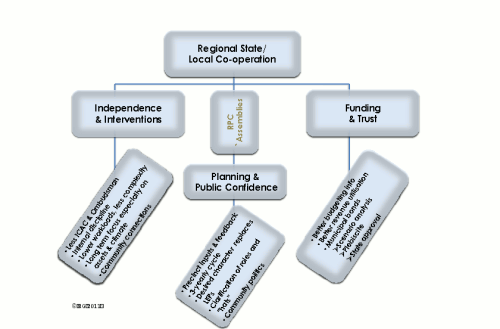The reduction or rationalisation of the number of municipal councils is a continuing issue in NSW.
There are conundrums of over a century in age including:
-
How to redress the splintered metropolitan governance structures most cities have? – 62 in Sydney alone, which has more public confidence issues than most
-
How to eliminate corruption, conflict and council sackings?
-
How to improve efficiency in local delivery systems?
-
How to energise local democracy and help councillors to be effective community leaders?
-
How to broaden the tax base underpinning infrastructure without alarming taxpayers?
-
How to increase the confidence of state governments in their local cadres sufficient to allow a mature and independent co-existence?
Advertisement
The Division of Local Government (DLG) has organised a seminar soon on "Destination 2036", to develop a four-year and longer term plan which successfully address "amalgamations, boundary changes, resource sharing and even whether councils in different areas should have different levels of responsibility". It is an internal industry forum, organised with the Local Government and Shires Association (LGSA), the managers' union (LGMA) and the Australian Centre of Excellence for LG (ACELG).
Will local community prospects be enhanced by the traditional approaches of NSW local government (as opposed to the best proven ideas from other jurisdiction's and even those of our ancestors); or will it be local managers' perpetual fear, BOHICA – bend over, here it comes again?
Is rationalisation appropriate, or necessary, or enough? Will NSW finally be evidence-driven through the many issues as Victoria has long been? Will evidence relate to known problems and data trends about community and economy; or to political and personal/industry predilections?
Most community leaders, councillors and managers are looking for inspiration if not salvation. There have been many inquiries into general and specific circumstances of councils. From all of these a list of over 40 major reform areas was derived by the current author. Each problem could have a solution; and the parts should stand as a coherent whole. Solutions were assessed against best practice criteria.
It is most important to develop reform schemes which are in harmony with the dominant culture and history of society. One creative set of responses was described in an earlier piece. This addresses old problems in new ways, not proposed in any other report, broadly as follows.

Advertisement
In historical context, councils have resisted amalgamations and "district" councils, and most notably in the 1950s the LG Association wanted to pursue district governments but its membership repressed the attempt. At the time councils were fighting co-operative planning through a County arrangement.
Among history's lessons, the Sydney Corporation Act 1842 allowed the appointment of specialist outsiders to the Council in addition to elected aldermen. (The Greater London Authority and others have a two-part franchise, to separate representation from leadership.)
Second, in 1880 the NSW Parliament set up a partnership with local government to fix Sydney's massive water, sewerage and drainage problems. There were three "presidential" directors appointed by the Government; with four other directors elected by the constituent councils.
Discuss in our Forums
See what other readers are saying about this article!
Click here to read & post comments.
About the Author
Robert Gibbons started urban studies at Sydney University in 1971 and has done major studies of Sydney, Chicago, world cities' performance indicators, regional infrastructure financing, and urban history. He has published major pieces on the failure of trams in Sydney, on the "improvement generation" in Sydney, and has two books in readiness for publication, Thank God for the Plague, Sydney 1900 to 1912 and Sydney's Stumbles. He has been Exec Director Planning in NSW DOT, General Manager of Newcastle City, director of AIUS NSW and advisor to several premiers and senior ministers.